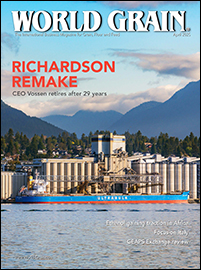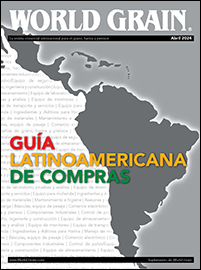The story of Wheat Montana is more than a clear depiction of the farm-to-table movement; it’s also a story of the American dream.
Living the dream
The Wheat Montana farm, owned and operated by Dean Folkvord and his wife, Hope, began as a simple family operation in Helena, Montana, U.S. It was started by Folkvord’s late father, and after years of struggling and surviving poverty, weather and the U.S. farm crisis of the 1980s, a bit of luck and good old-fashioned hard work helped the Folkvord farm succeed with hard white wheat crops, some of the first to be grown in this country.
Around 1986, McDonald’s expressed interest in a hard white wheat hamburger bun, and the family met a baker in the Bozeman, Montana, U.S., area. While the McDonald’s deal didn’t pan out, it got the Folkvord family interested in the specialty baking business.
“We partnered with a guy who owned a 1,200-square-foot bakery in Bozeman,” Folkvord said. “It cost us $80,000, but it was at a time when we had some extra money, and he had some really great ideas. Two years later, he had all our money, and we had all his ideas.”
At that time, the bakery was bleeding money, and the Folkvords faced the decision to call it quits and return to the farm or soldier through and attempt a recovery. Folkvord applied farmer’s metrics — and work ethics — to the bakery and leaped into the world of baking. In 1993, he launched the wholesale operation off I-90, where it still stands today.
Folkvord added a deli in hopes of cashing in on the Starbucks trend. It did a couple hundred dollars a day in sales that soon escalated to a couple thousand, and the deli eventually became the means by which he supported the bakery’s capital expansion.
“When we moved out here, we disrupted everything,” he said. “Our production was goofy for a while as we got used to the new equipment, and when we had payments to make, the deli floated the boat.”
From farm to food
With the bakery as the force binding the farm and the food, Wheat Montana set the stage for what would eventually provide its biggest growth initiative: selling bread to the food service market with the farm as its main selling point.
Although the company’s “local farmer” status and innovation has supported retail growth during the past three years, its food service division has grown by double digits over the past eight.
“A big part of that is our small-batch, craft baking,” said Bo Maurer, vice-president, sales and marketing. “Whether it’s flavor and taste or the strength of a bun to hold up to a hamburger, the quality of our bread is a huge point of differentiation.”
Part of that has to do with the authenticity of the Wheat Montana story. “Everywhere you look, you can read about consumers’ interest in transparency,” Mr. Maurer observed, noting that small-batch bread is gaining ground with consumers skeptical of “big food” and the longer shelf life often associated with such products. It’s not just the farm’s association with the bakery but also the family’s personal story that paints the picture of the brand.
Other areas of the business, including wholesale grains and retail bread, buns, cereals and grains, are also going strong. That’s thanks to the Wheat Montana story and the company’s commitment to small-batch, high-quality products and the onsite hammer mill, which produces the whole-milled whole wheat flour used in the plant and also sold to wholesale customers and retail outlets.
One aspect of Wheat Montana’s products that sets them apart is their high-protein content, a benefit traceable directly to the farm. Its high elevation and limited moisture, along with Montana’s hot days and cold nights, put stress on the crops that increases the protein content and quality. Think of the human body when a hard workout tears down the muscle to make it stronger.
“One great thing with our grain is that the high elevation and growing conditions shrink the division between total protein and that which is beneficial for baking,” said Jason Kovnesky, plant operations manager.
Because of this, Wheat Montana all-purpose white flour functions more like a bread flour. And finished products, such as Wheat Montana’s high-protein chia bread, offer so much protein that some can fulfill the recommended Daily Value in just a couple of slices.
A different kind of ‘greenfield’
Growing its own wheat runs far deeper than just a marketing message for Wheat Montana; it’s the heartbeat of the business, the core of the company and the basis for the bread. While many large-scale operations have the means to employ high-tech sustainable building design, Wheat Montana does sustainability old-style — on the farm.
“No one knows sustainability better than farmers,” Maurer attested.
Sitting atop a 5,000-foot elevation, Wheat Montana cultivates a variety of hard white wheat, along with chickpeas grown on a separate 750-acre patch. All crops are rotated on an annual basis to avoid overuse in any one section of the land; growing the chickpeas — a very lucrative crop — provides much-needed nitrogen for the soil and reduces the need for extra fertilizer in the following season once wheat is rotated onto the next plot of land.
Wheat Montana’s sustainable farming practice further supports the company’s farm-to-table and traceability benefits. For example, the farm’s nitrogen usage has garnered attention from customers such as Wal-Mart, which places a heavy emphasis on sustainability and traceability for its food suppliers.
After making a presentation to the retail giant about Wheat Montana’s efforts in naturally reducing fertilizer input through increased nitrogen production, Wal-Mart used the company as a case study to push other large suppliers to track and decrease fertilizer usage.
“We were the only company who could actually track everything ourselves as opposed to going through the co-op and the elevator,” Maurer explained. “We found ourselves on conference calls with Kraft and PepsiCo, and they were asking, ‘How do we track this information?’ But we are able to do it, and Dean was able to share that.”
Stop … hammer time
Considering this bakery’s farm roots, it’s no surprise that it emphasizes attributes such as all-natural, non-GMO (for which it was certified this year) and organic (a line of organic bread will launch in October). It also is working on eliminating allergens from all formulations.
Everything starts with the grains.
After harvest, wheat is transported up the road to the plant, where it is received for cleaning and processing and is then either milled or packaged to be sold as raw grain to retail bakers. The company mills 60% to 70% into flour for use in the bakery or packaged to sell at retail and wholesale.
For its grain processing, Wheat Montana relies on traditional methods, including aspiration and shake tables, supported by modern color-sorting technology.
When the raw grain first arrives from the field, it is sent through a shaker table that separates imperfections and any foreign pieces such as rocks or chaff that may have made its way from the combine. Next, it is augured over to a de-stoner that further removes impurities before the grain is elevated to the new AMBC color sorter, a machine that has a digital, preprogrammed image of how the grain should look.
As a hailstorm of grain rains down individual slides to the sorter, every kernel is viewed with a series of lights that searches for any imperfection that may indicate ergot or problems. Any imperfect kernel is blown off the track.
After this extensive cleaning process, raw grain is bagged for sale to retail bakery customers, and the rest is funneled over to the flour room for impact milling.
In a traditional hammer mill, the hammer implodes the whole kernel until it is small enough to fall through the screen. This method ensures that every part of the grain is used — bran, germ and all — and nothing is added or removed.
“You take the wheat, drop it through, and it gets crushed, and what comes out is our whole wheat flour,” Maurer explained. “There’s no separation and reconstituting, so you get 100% nutritional value of the grain.”
The process lends itself to positive baking attributes as well.
“From a keeping perspective, it’s a natural balance, so you don’t have more germ, where you might have a greater chance of rancidity,” Kovnesky noted. “By maintaining the natural constitution of the kernel, we actually find more nutritional value as well as better keeping quality. And frankly, from a baker’s perspective, I think it has great baking characteristics as well.”
The company consumes more than 100,000 pounds of flour a day for both sale and its own operations. In the flour room, the milled flour is either bagged for sale or packed into totes on three lines where about five or six employees work two shifts, five days a week.
In this same room, the company also runs a line for packaging cereals, mixes, milled flax and chia seed for retail. Wheat Montana has seen tremendous growth for these products in only a matter of months, so plans for updating the packaging line for this portion of the business are about to get under way.
The low-hanging fruit
For two decades, Wheat Montana has been well-known in its home and neighboring states. It is now picking up momentum across the United States as it gains more attention from national customers such as Wal-Mart and Sprouts. With this comes the need for continuous improvement, so Wheat Montana recently enlisted industry veteran John Khoury as the company’s CEO. He is charged with streamlining the process, improving efficiencies and growing sales.
“When I first saw the bakery, it was well-run, but there was some low-hanging fruit for improvement,” Khoury said, recalling one of his first visits to the bakery.
“The best thing about Wheat Montana is the product,” Khoury said. “When I go to the end of the line, I see product just loaded with seeds and grains, and the formulations are phenomenal.” He credited industry veteran Don Ashton, Wheat Montana’s director of compliance and product development, as well as the support and relationships the company has with its suppliers as the reasons Wheat Montana’s natural, organic and non-GMO product formulations have had success.
Being all-natural means Wheat Montana bread does not use any chemical dough strengtheners or improvers (ascorbic acid is about as strong as it gets); therefore, the bakery functions as a straight no-time operation. Bread runs through from mixing into the proofer in about 7 to 8 minutes. All told, from mixer to packaging, a loaf of bread is processed in about 3 hours.
To get through this process in time, operations must go off without a hitch. To ensure this, one of Khoury’s first orders of business was making sure the plant floor runs like a well-oiled machine.
“John’s philosophy in terms of machines is to restore equipment to its original working condition and then innovate or improve from there,” Kovnesky said.
Even just simplifying or fixing small issues can make a huge difference not only in the efficiency of the process but also in worker satisfaction.
“Fixing even the smallest issues makes an impact,” Khoury said. “I want people to come into work, do their job in a good atmosphere and then be able to go live their lives outside of work.”
Into the great divide
A typical week at the plant sees about 200 employees creating, packaging and distributing more than 225,000 units, whether individual bread loaves, packages of buns or retail mill products. These are either delivered fresh through direct-store delivery or shipped frozen to cold storage units in Oregon and Colorado, where they will be sent out to various food service customers.
Running around the clock five days a week, the bakery alternates bread and bun production on its two lines. During a tour by World Grain’s sister publication Baking & Snack, Wheat Montana was producing bread loaves for Mad Greens, a Denver, Colorado, U.S.-based food service customer whose representatives were also visiting the bakery and farm. It also was making loaves of its enrobed, high-fiber and flaxseed bread, the No. 1 selling retail product. Operating speeds for these highly specialized items run about 50 loaves per minute.
Flour comes in from the mill through a hopper and directly into one of three Topos Mondial 600-lb spiral mixers. Minor ingredients are hand-scaled and added, and the batch mixes for about 10 to 15 minutes. This particular retail bread carries 5% of its dough weight as sunflower seeds, which are razor-sharp, so proper mixing is of the utmost importance.
Because the bakery runs so many stock-keeping units, the small-batch mixers provide the necessary flexibility.
“Smaller batches keep the dough fresher throughout processing,” Khoury said. “In addition, with our artisan formulas, small batches are required to maintain quality and be responsive to customer needs.”
Once the dough is mixed, it is lifted into the Gemini/W/P model B 700 6- and 3-pocket bread divider with an extended s/s hopper running 27 to 42 oz.
“Bread dividing is done on weight and volume, but the chambering side expands the volume,” Kovnesky explained. “As dough becomes gassier, you actually need more dough volume to get the same weight. So by keeping it at a consistent level here, we adjust it from the top down to the bottom, and we’re able to keep that scaling weight the same.”
Because for Wheat Montana, quality is synonymous with consistency, Kovnesky noted that accurate scaling is a top priority. In fact, scaling weight efficiency was a high priority for Khoury’s continuous improvement projects.
“With our old divider, you had to scale it heavy just to make sure the customer got the product,” Kovnesky recalled. “With this equipment, we can take 15 pieces of dough and stay within 2 to 3 g. We’re very happy with the partnership we have with Gemini; it has saved us money and reduced waste, and our customers are happy because they’re getting the same sized loaf.”
This makes a big difference for customers like Mad Greens who rely on consistent bread for its sandwiches.
No time to relax
Once divided, the straight no-time dough heads into an AMF Bakery Systems conical rounder and moves up to the sheeter/moulder with only 45 seconds to rest.
“Our challenge is that the majority of our product is either whole grain or 100% whole wheat product, so we’re not able to work it as much as a white pan dough,” Kovnesky said.
The bakery’s current sheeter/moulder is what Khoury refers to as an “old reliable,” noting that while the company had capital reserved for a new one, he reallocated those funds for other more pressing improvements. He plans to investigate his options at the International Baking Industry Exposition (IBIE), Oct. 8-11 in Las Vegas.
“We’re all on board with this plan because the only issue we really had in this area was the pan stop,” Kovnesky added.
To address this issue at the end of the makeup line, Wheat Montana enlisted the help of engineering students from Montana State University in Bozeman. Led by Wheat Montana intern John Owolabi, the group developed an improved system for managing the varied sizes of pans from American Pan, a Bundy Baking Solution, that the bakery uses.
Because of the different sizes, uneven spacing prevented the pan stop from cycling through as fast as needed when time was of the essence. To address this, the group developed a system where different pans will go from side stop to bottom stop to different sensor eyes in different locations. Implementation will begin this fall for the prototype the interns developed this summer.
Before the pan stop, some of the topped and enrobed bread loaves, such as those running today, are sent through a Burford seeder/topper and pressure board assembly.
“We have several varieties of pan and hand-enrobed breads, and our Seed Lovers has 17 different seeds and grains,” Kovnesky said. “When we’re processing it, we have staff down here hand-rolling the seeds to make sure we get each loaf covered. We don’t want people to just say, ‘Oh, it just has seeds inside.’ It needs to be eye-appealing.”
Restoration of hardware
After proofing on racks for about an hour and baking in one of 13 MacAdams rack ovens, loaves continue to a Capway depanning system, newly refurbished by Topos Mondial, with racks arriving every 2 to 3 minutes.
Once the bread is depanned, it heads upward on a Stewart Systems conveyor for ambient cooling, and the pans travel through a Henry Group pan cleaner, also refurbished by Topos, and back to the front of the line.
Before the installation of this new system, pans were manually stacked and unstacked on pallets up to five times in a 7-hour period; now, everything is in constant motion.
“This allows us efficiencies in staff and scheduling,” Kovnesky said. “Now, we have one person feeding the pans and monitoring what’s going on. We don’t need an extra person stacking the pans anymore, so we reassigned that person to another area.”
Bread cools on elevated conveyors for about an hour (buns for about half that). The process lowers the core temperature to avoid molding in the bags without losing moisture in the center. Packaging, another area in which Khoury invested restoration funds, uses a Bettendorf Stanford slicer/bagger for bread and a UBE system for rolls.
Both pieces of equipment have been reliable for the bakery, but over time, continued adjustments add up, and they just didn’t function as well as they used to. Under Khoury’s philosophy, restoring them to their original condition changed the preventive maintenance paradigm completely.
“We went from thinking there must be something wrong with the equipment to doing a total reset, and it makes all the difference,” Kovnesky said of the restored equipment, which runs 63 loaves per minute.
Mary Frisby, the packaging line supervisor, noted that before the improvements, product waste was high. Now, the bread bagger runs with minimal or no waste.
For its fresh business, code dating through the Kwik Lok closure is critical.
“We have to be able to track product for recall purposes, so we stamp lot numbers on all the bags,” Kovnesky noted.
Tapping into talent
Remember Owolobi, the intern leading the pan stop charge? He actually reconfigured the case- and tray-loading area over the summer to streamline the end of the process.
Previously, one person boxed about 30 loaves a minute; Owolobi suggested adding a conveyor that would feed into the taper.
“We put in a conveyor that goes into the machine when they had to do it by hand before,” Mr. Owolobi explained. “Now they can box and slide the case down to a conveyor. It automatically gets pushed into the taper, and then someone stacks it.”
For tray loading, he streamlined the system by moving the trays and the loading staff to the same side of the conveyor. For bread and buns, the project increased the throughput by about three units per minute and reduced the labor by two people in the area. With the process streamlined, the next step will be adding a new case erector, also on the “wish list” for IBIE.
Thanks to Khoury’s leadership and expertise, no “rock is unturned” as he continues to investigate cost savings and efficiency improvements in all areas of the company’s operation. As operational efficiencies continue to increase, Wheat Montana is becoming more than just a blip on the radar. Expect to see contingents at IBIE and other conferences such as the American Society of Baking’s BakingTech next February, where Khoury will be part of a session panel.
The message he intends to get out is the quality that goes into the process, from the thousands of acres of farm next door to the hundreds of SKUs going out of the plant.
For Kovnesky, the proof is in the product.
“Truly, the metric or test for us is if you’re proud of it as you’re walking up and down that bread aisle or proud of it as the chef is about to open up the package, then it’s quality bread,” he said. “When every stakeholder of the company understands that that’s how we define it, then that excels us on what we consider quality to be.”
To view the slideshow, click here.














